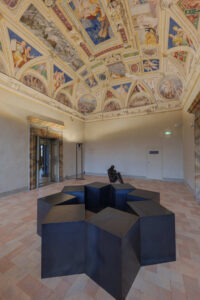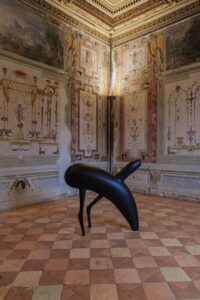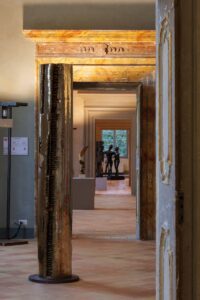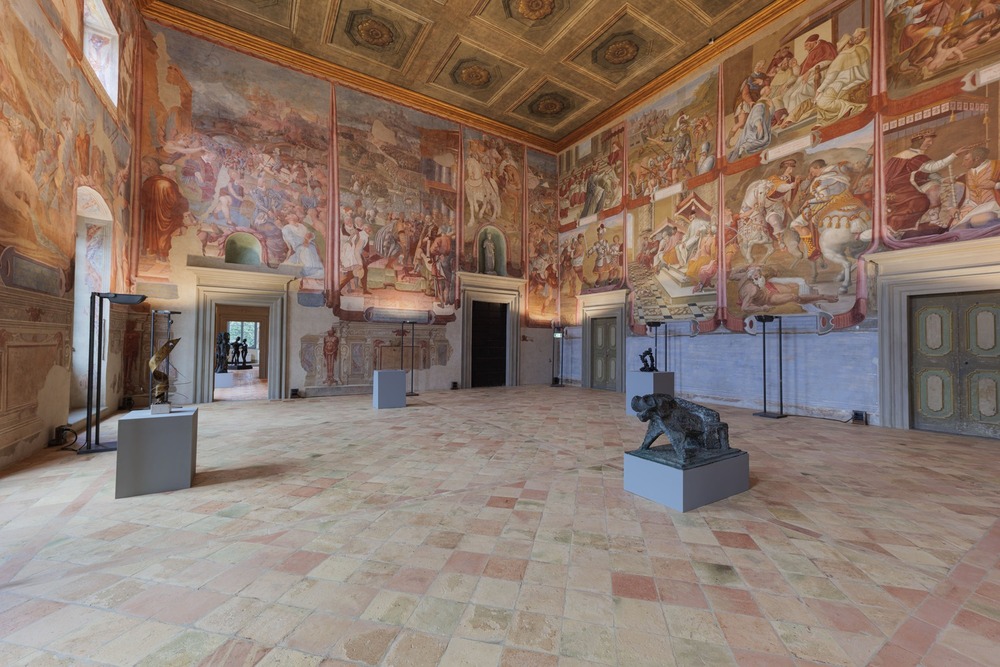By Our Editorial Staff
A major exhibition in Città di Castello, in the scenic historic setting of Palazzo Vitelli in Sant’Egidio, will be open until June 29, 2025. In the fifteen rooms of the splendid Renaissance palace, the works of 29 internationally renowned artists will be showcased.

The history of sculpture in Italy in the fifteen Renaissance rooms of Palazzo Vitelli in Sant’Egidio; On the occasion of the completion of the works that have brought the noble palace, owned by the Cassa di Risparmio di Città di Castello Foundation, back to its ancient decoration, the Palazzo Vitelli Association in Sant’Egidio in collaboration with the “Palazzo Albizzini Foundation Burri Collection”, has organized an exhibition entitled “METALLICA. Sculpture in Italy 1947 – 2025”, inaugurated on March 30 and scheduled until June 29, 2025, with the patronage of the municipality of Città di Castello.
The association is also responsible for managing in certain spaces of Palazzo Vitelli in Sant’Egidio, this splendid Renaissance residence, a Documentation Center of Contemporary Arts, currently being activated, which will provide a wide range of users with information and documentation on artists, art movements of recent decades and on regional, national and international cultural events.
The exhibition “METALLICA. Sculpture in Italy 1947- 2005” curated by professor, Bruno Corà was conceived with significant works of art signed by Italian artists in the last eighty years; the exhibition thus intends to anticipate the inauguration of the Documentation Centre, also allowing the public to view the environmental redevelopment works, consolidation of spaces, restorations and decoration works. The exhibition includes twenty-nine artists: Fontana, Mirko, Marini, Uncini, Pomodoro, Colla, Baj, Cagli, Mattiacci, Spagnulo, Mannucci, Manzù, Consagra, Melotti, Pardi, Ranaldi, Bove, Paladino, De Chirico, Kounellis, Rizzoli, Protti, Isgrò, Bassiri, Mainolfi, Staccioli, Salvadori, Zazzera and Termini, whose sculptures unfold in the fifteen rooms of the Palace.
 The works on display, self-supported and therefore usable without the need to occupy the walls, thus leave the individual gaze free and allow you to appreciate the important frescoes and any other decorative element existing in the spaces of the Renaissance building. “The repertoire of works chosen for this event with the common denominator of metal – explain the President of the Fondazione Cassa di Risparmio di Città di Castello and Associazione Palazzo Vitelli a Sant’Egidio, Fabio Nisi and the President of the “Burri” Foundation, Bruno Corà – does not presume or aspire to be exhaustive in relation to the richness of the plastic expression of Italian art, but rather to constitute an emblematic exemplary review of ways that have come to the fore of the art scene from the second post-war period of the twentieth century and up to the present day.
The works on display, self-supported and therefore usable without the need to occupy the walls, thus leave the individual gaze free and allow you to appreciate the important frescoes and any other decorative element existing in the spaces of the Renaissance building. “The repertoire of works chosen for this event with the common denominator of metal – explain the President of the Fondazione Cassa di Risparmio di Città di Castello and Associazione Palazzo Vitelli a Sant’Egidio, Fabio Nisi and the President of the “Burri” Foundation, Bruno Corà – does not presume or aspire to be exhaustive in relation to the richness of the plastic expression of Italian art, but rather to constitute an emblematic exemplary review of ways that have come to the fore of the art scene from the second post-war period of the twentieth century and up to the present day.
From Lucio Fontana’s spatialist sculpture of 1947 to that of Melotti, from Colla to Pomodoro, from Mirko to Cagli and other sculptures, up to those of the Masters of the generations still living, Ranaldi, Mainolfi, Salvadori, Rizzoli, Protti, Bassiri and others, each work has found its place in a path in which the protean identity of the language of Italian metal sculpture is highlighted in the face of other international scenarios. On the occasion of the exhibition it will also be possible to visit the rooms dedicated to the activities of collection, classification, protection, study and dissemination of the materials that will reach the Centre in the course of its future activity.”
Opening hours: Friday, Saturday and Sunday, 10.00 am – 1.00 pm / 2.00 pm – 6.00 pm.

Info: segreteria@fondazionecaricastello.it; info@fondazioneburri.org; www.fondazionecaricastello.it; www.fondazioneburri.org; www.comune.cittadicastello.pg.it / tel. 075 8555757 / free admission
PALAZZO VITELLI IN SANT’EGIDIO
Splendid building built around the middle of the sixteenth century for Paolo II Vitelli (1519-1574), a famous leader in the service of the Farnese of Parma and Emperor Charles V. The façade towards the garden shows a high portico with five arches originally supported by columns which, damaged by the earthquake of 1789, were incorporated into the large pillars. In the large vaults of the entrance and the portico you can observe architectural details and pictorial decorations that recall Tuscan models.
The architect is not known with certainty, although some scholars hypothesize that Ammannati intervened. Through a wide staircase, with a vault frescoed by Prospero Fontana, you reach the hall on the main floor, once vast, which after a fire in 1686 was reduced to its current proportions. On the walls the artist himself, assisted by Cristofano Gherardi, known as Doceno, Orazio Samacchini and Pomarancio illustrated the exploits of the Vitelli family. This is followed by a series of rooms, with splendid sixteenth-century coffered ceilings, carved, gilded and painted, or covered vaults decorated with stuccoes and paintings of the ‘500 and ‘600.
The Palace overlooks what was once a splendid Italian garden, where we still find a grove of holm oaks and a nymphaeum. The vast garden is fenced to the north-east by the ancient city walls and at the bottom, on a rise, appears the elegant architecture of the Palazzina Vitelli, built around a medieval turret. The loggia is frescoed by Fontana and his pupils with landscapes, festoons of fruit and flowers and a mythological scene.
